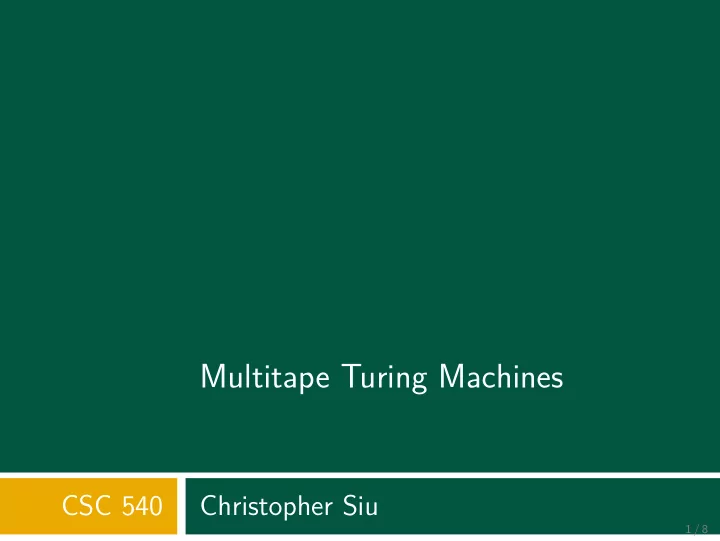

Multitape Turing Machines CSC 540 Christopher Siu 1 / 8
Multitape Turing Machines Defjnition A k -tape machine has k tapes and k independent tape heads. The machine reads the tapes simultaneously, but has only one state. Tape 3 Tape 2 Tape 1 q i 2 / 8
Multitape Turing Machines A multitape machine begins with the input in the standard position on Tape 1. Tape 3 Tape 2 a a b a Tape 1 3 / 8 q 0
Multitape Turing Machines During each transition, a multitape machine may: 1 Change the state. 2 Write (potentially difgerent) symbols to each tape. 3 Independently reposition each tape head. Defjnition The transition function of a two-tape machine is of the form: 4 / 8 δ ( q i , x 1 , x 2 ) = ( q j , y 1 , d 1 , y 2 , d 2 ) q i , q j ∈ Q are the starting and ending states. x 1 , x 2 ∈ Γ are scanned from Tape 1 and Tape 2. y 1 , y 2 ∈ Γ are written to Tape 1 and Tape 2. d 1 , d 2 ∈ { L , R , S } are the directions for Head 1 and Head 2.
Multitape Turing Machines : Construct a multitape machine that, given an input BwB (on Tape Example Example 5 / 8 Consider the following two-tape machine to accept a i ba i | i ≥ 0 � � ( a / a R , ( a / a R , B / a R ) a / a L ) ( B / B R , ( b / b R , ( B / B R , B / B R ) B / B L ) B / B R ) > q 0 q 1 q 2 q 3 1), where w ∈ { a , b } ∗ , produces the output BwwB (on Tape 1).
Converting Multitape to Multitrack Machines Track 5 Track 1 a b a Track 2 X Track 3 a b Track 4 X # Theorem q i Tape 1 a b a Tape 2 a b Example if it is accepted by a standard Turing machine A language L is accepted by a multitape Turing machine if and only 6 / 8 Note that a k tapes can be simulated by (2 k + 1) tracks.
Converting Multitape to Multitrack Machines 1 Find the ‘ X ’ on track 2; transition based on track 1. 2 Find the ‘ X ’ on track 4; transition based on track 3. Note that we now know the symbols scanned from the “tapes”, so 3 Write to tracks 1 and 3; move the ‘ X ’s on tracks 2 and 4. Example q i q j 7 / 8 To simulate a transition of a 2 -tape M , a 5 -track M ′ must: we know — at machine-design-time — the desired output of δ . Consider simulating δ ( q i , a , b ) = ( q j , b , L , aR ) : ( a / b L , b / a R )
Converting Multitape to Multitrack Machines Example (cont.) 8 / 8 (where ∗ indicates “any symbol”, and { c } , “any symbol other than c ”) ( a , X , ∗ , ∗ , ∗ )/ ( ∗ , { X } , ∗ , ∗ , ∗ )/ ( ∗ , ∗ , ∗ , ∗ , { # } )/ ( a , X , ∗ , ∗ , ∗ ) L ( ∗ , { X } , ∗ , ∗ , ∗ ) R ( ∗ , ∗ , ∗ , ∗ , { # } ) R ( b , X , ∗ , ∗ , ∗ )/ ( b , X , ∗ , ∗ , ∗ ) L ( ∗ , ∗ , ∗ , ∗ , # )/ ( ∗ , ∗ , ∗ , ∗ , # ) R ( ∗ , ∗ , ∗ , { X } , ∗ )/ ( ∗ , ∗ , ∗ , ∗ , { # } )/ ( ∗ , ∗ , ∗ , { X } , ∗ ) R ( ∗ , ∗ , ∗ , ∗ , { # } ) R ( ∗ , ∗ , b , X , ∗ )/ ( ∗ , ∗ , a , X , ∗ )/ ( ∗ , ∗ , b , X , ∗ ) L ( ∗ , ∗ , a , X , ∗ ) L
Recommend
More recommend